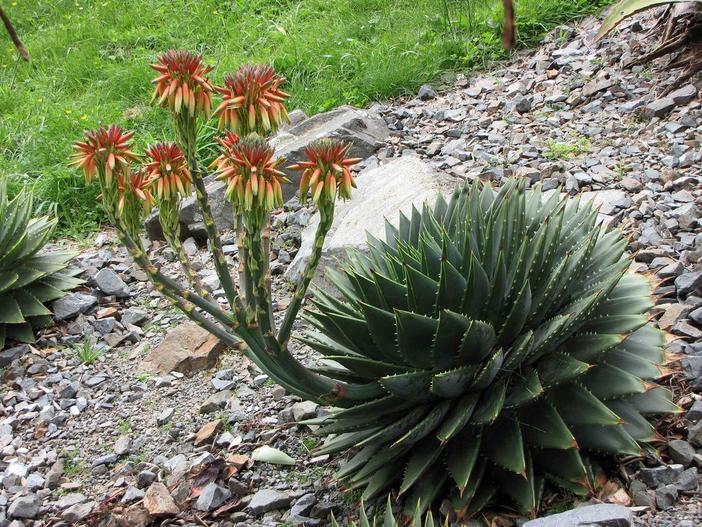Spiral Aloe
(Aloe polyphylla)
Spiral Aloe (Aloe polyphylla)
/
/

阿橋花譜 HQ Flower Guide
CC BY-SA 2.0
Image By:
阿橋花譜 HQ Flower Guide
Recorded By:
Copyright:
CC BY-SA 2.0
Copyright Notice:
Photo by: 阿橋花譜 HQ Flower Guide | License Type: CC BY-SA 2.0 | License URL: https://creativecommons.org/licenses/by-sa/2.0/ | Uploader: 阿橋 KHQ | Publisher: Flickr


























Estimated Native Range
Summary
Aloe polyphylla, commonly known as Spiral Aloe, is an evergreen succulent native to the mountainous regions of Lesotho, where it is found on grassy slopes at high altitudes. This unique plant is adapted to a cool, alpine climate and is often exposed to mist and clouds. It typically grows to a height of 1 foot (0.3 meters) and a width of 2 feet (0.6 meters). The Spiral Aloe is renowned for its distinctive spiral pattern, with leaves arranged in five rows that form a perfect rosette. The fat, wide, serrated, gray-green leaves have sharp, dark leaf-tips, adding to its dramatic appearance.
The Spiral Aloe is celebrated for its sculptural form and the striking spirals it creates, making it a prized specimen in rock gardens, succulent collections, and as a container plant. It blooms in late spring to early summer, producing robust, branched inflorescences topped with tubular flowers that can range in color from red to salmon pink and occasionally yellow. While it does not typically produce offshoots, it can form small, dense clumps from seed germination. In cultivation, it requires full sun, very low to low water, and well-draining soil to prevent root rot. It is also important to protect it from excessive winter moisture. Due to its rarity and difficulty in cultivation, it has been awarded the Royal Horticultural Society’s Award of Garden Merit in the UK. However, it can be susceptible to fungal diseases if not provided with the right conditions, and it is notoriously challenging to keep alive outside its native habitat.CC BY-SA 4.0
The Spiral Aloe is celebrated for its sculptural form and the striking spirals it creates, making it a prized specimen in rock gardens, succulent collections, and as a container plant. It blooms in late spring to early summer, producing robust, branched inflorescences topped with tubular flowers that can range in color from red to salmon pink and occasionally yellow. While it does not typically produce offshoots, it can form small, dense clumps from seed germination. In cultivation, it requires full sun, very low to low water, and well-draining soil to prevent root rot. It is also important to protect it from excessive winter moisture. Due to its rarity and difficulty in cultivation, it has been awarded the Royal Horticultural Society’s Award of Garden Merit in the UK. However, it can be susceptible to fungal diseases if not provided with the right conditions, and it is notoriously challenging to keep alive outside its native habitat.CC BY-SA 4.0
Plant Description
- Plant Type: Succulent
- Height: 0.8-1 feet
- Width: 1-2 feet
- Growth Rate: Moderate
- Flower Color: Red, Orange, Pink
- Flowering Season: Spring, Summer
- Leaf Retention: Evergreen
Growth Requirements
- Sun: Full Sun
- Water: Medium
- Drainage: Fast
Common Uses
Bee Garden, Bird Garden, Border Plant, Drought Tolerant, Fire Resistant, Hummingbird Garden, Low Maintenance, Potted Plant, Rabbit Resistant
Natural Habitat
Mountainous regions of Lesotho, grassy slopes at high altitudes, cool, alpine climate, often exposed to mist and clouds
Other Names
Common Names: Coiled Aloe, Many-Leaved Aloe, Basotoland Aloe
Scientific Names: , Aloe polyphylla,
GBIF Accepted Name: Aloe polyphylla Pillans